What is PoE?
Power over Ethernet (PoE) is a standard that allows Ethernet cables to transmit data and power simultaneously using a single network cable. This allows system integration and network installers to deploy powered devices in locations that lack electrical circuitry. In addition, PoE eliminates the expense of installing additional electrical wiring, requiring professional electrical installers to ensure that strict conduit regulations are followed.
PoE technology sends 10/100/1000 Mbps of data and 15W, 30W, 60W, and up to 90W of power budget to devices over Cat5e, Cat6, Cat6a. Cat7 and Cat8 Ethernet cables for a maximum distance of 100m.
PoE technology relies on the IEEE 802.3af, 802.3at, and 802.3bt standards set by the Institute of Electrical and Electronics Engineers and governs how networking equipment should operate to promote interoperability between devices.
PoE-capable devices can be power sourcing equipment (PSE), powered devices (PDs), or sometimes both. The device that transmits power is the PSE, while the device that is powered is a PD. Most PSEs are either network switches or PoE injectors intended for use with non-PoE switches.
The most common types of PoE applications include:
- VOIP phones
- IP cameras
- Wireless Access Points
However, PoE can also power other devices, including:
- PoE lighting
- ATMs
- IP intercoms
- Security card readers
- IP clocks
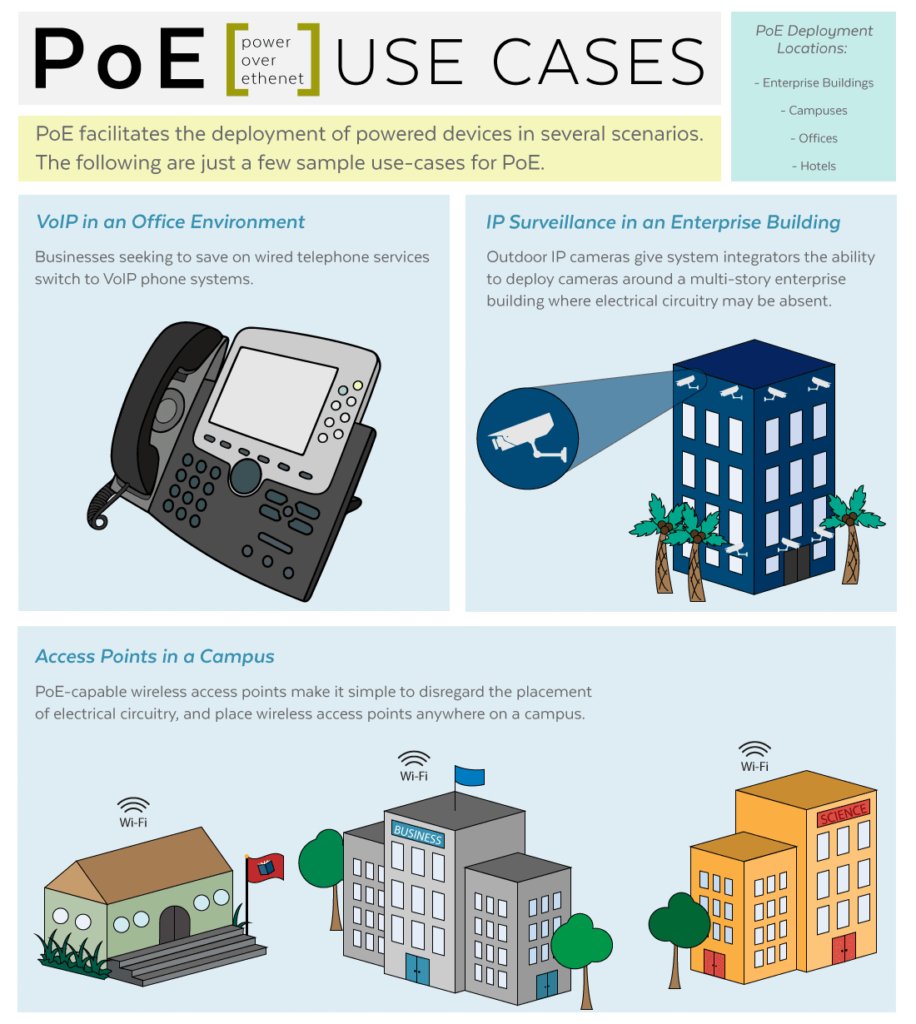 PoE Definitions
PoE Definitions
Even though PoE is relatively simple to deploy, network administrators need to understand some of the devices, terms, and technology involved.
PSEs vs. PDs
Power sourcing equipment (PSE) refers to devices responsible for supplying power to connected devices, such as switches, hubs, and injectors. Powered devices (PDs) receive power from PSEs. A few examples of PDs include IP cameras, VoIP, and wireless access points (WAPs)
Mode A vs. Mode B
PoE devices often use different power pinout pairs. These two methods are known as “Mode A” and “Mode B.”
With Mode A, data pin pair 1-2 forms one side of the DC supply, and pin pair 3-6 forms the other side, leaving pinout pairs 4-5 and 7-8 unused. Units that utilize Mode A are sometimes referred to as “end-span” units.
Unlike Mode A, Mode B leaves no data pinout pairs unused. Pin pairs 1-2 and 3-6 send data. Pin pair 4-5 form one side of the DC supply, and pin pair 7-8 form the other. Units that utilize Mode B are also referred to as “midspan” devices.
Though the differences between Mode A and Mode B are minimal, they are important to consider as disregarding which power pins are used to transfer and receive power can lead to non-functioning connections.
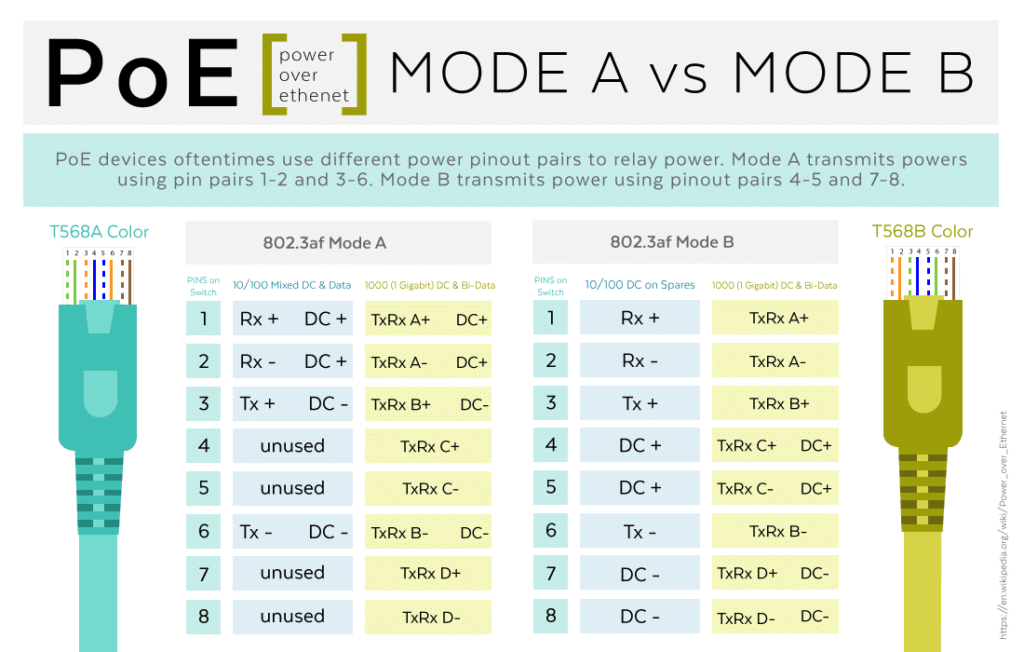 Endspan PSEs vs Midspan PSEs
Endspan PSEs vs Midspan PSEs
As mentioned above, the terms endspan and midspan are used to indicate which pinouts are used to send and receive power; however, endspan PSEs and midspan PSEs take on a more literal meaning.
Midspan PSEs are characterized as “intermediary” devices deployed between a non-PoE-capable PSE with a PoE-capable PD. Examples of midspan PSEs include power injectors or power hubs. On the other hand, endspan devices refer to the main PSE in a network, such as a switch.
Compatible PoE Devices vs. Compliant PoE Devices
These terms are NOT synonymous.
Though complaint devices are IEEE-certified, compliance indicates different attributes for PDs and PSEs. For example, for a PD to be considered compliant, it must have the ability to send and receive power using both Mode A and Mode B.
However, compliance standards for PSEs do not require the support of both modes. As a result, some compliant PSEs only support Mofe A, while others support only Mode B—still, others may support both A and B modes.
PoE-compatible devices do not adhere to IEEE standards; however, they may be reliable alternatives that require installers to ensure the correct modes are used for their networks. For example, PoE-compatible PDs will most likely support only Mode B. However, this varies from manufacturer to manufacturer, and there is no guarantee that they will support both power modes.
Similarly, PoE-compatible PSEs, such as injectors, can support either mode, but there will be no guarantee that they will support both modes. Therefore, when using PoE-compatible devices, it is vital that network installers and system integrators check specification data sheets to verify that their prospective units meet the power modes their network uses.
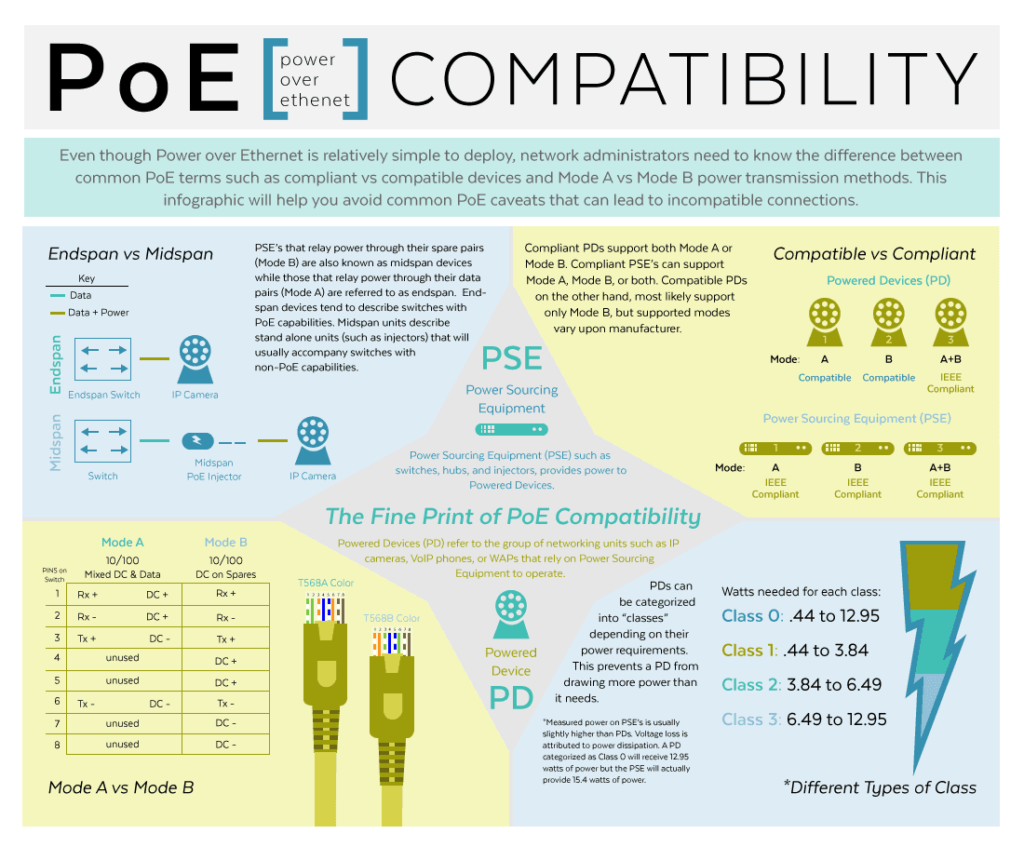 What are 802.3af and 802.3at PoE standards?
What are 802.3af and 802.3at PoE standards?
The Institute of Electrical and Electronics Engineers (IEEE) is responsible for creating PoE standards. Click here to learn more about IEEE’s standardization process. There are currently three PoE standards available. The 802.3af standard supports 15.4W of power. But even though 802.3at power sourcing equipment (PSE) can transmit 15.4W of power, powered devices (PDs) can only reliably receive 12.95W of power due to power dissipation.
In 2009, the IEEE introduced the 802.3at standard (also known as PoE+). This standard supports 30W of power, but similarly to the 802.3af standard, power dissipation causes PDs to receive slightly lower amounts of power, specifically 25.5W of power.
802.3bt (also known as PoE++) was ratified in 2018 and has two types (Type 3 and Type 4) offering higher power. The 802.3bt (Type 3) standard supports 60W of power, with PDs receiving 51W. The 802.3bt (Type 4) standard supports 100W which dissipates on the receiving end to 71.3W. This new standard essentially combines Mode A and Mode B to achieve the higher voltage and support 10 Gbps connections.
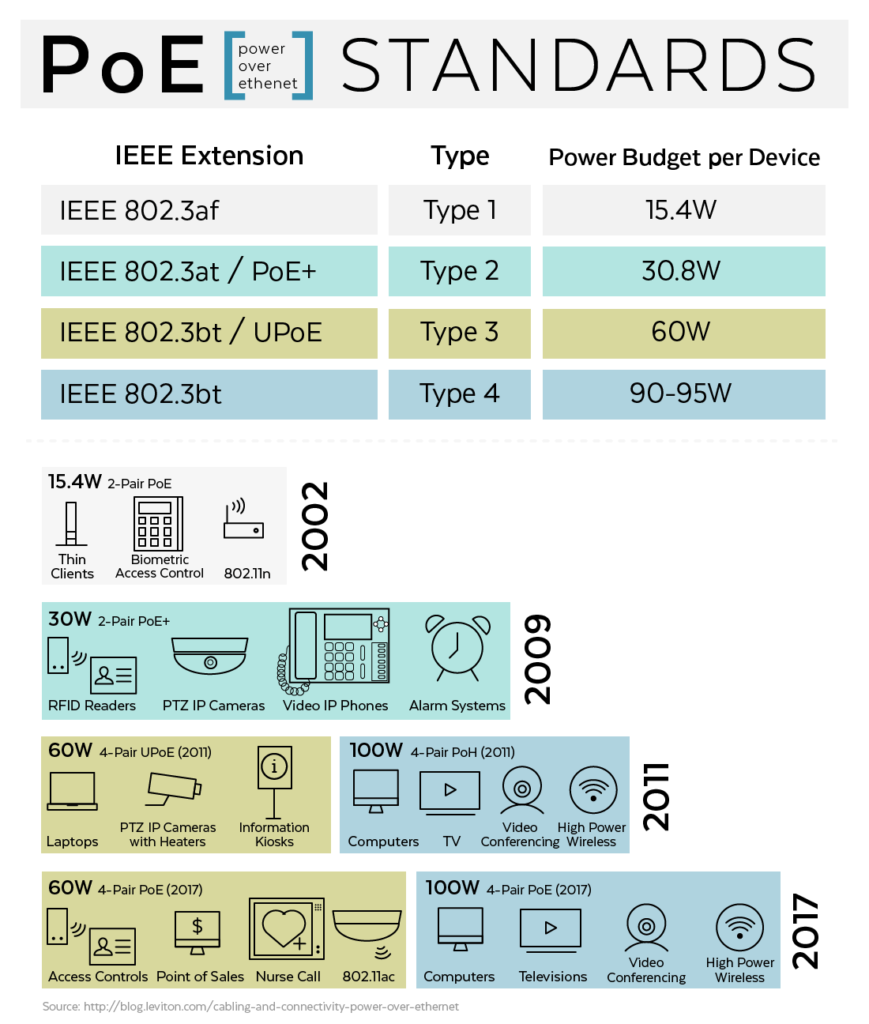 Why all the emphasis on 100W?
Why all the emphasis on 100W?
The higher power budget is particularly crucial for PoE lighting systems and platforms and for the other smart technologies currently being adopted. As businesses move further into smart technologies, automation is also inching its way into the picture. For example, smart PDs are automated—and automation needs more power. The smart device customer is becoming aware of what is possible with Ethernet power delivery and the IEEE 802.3bt standard and is taking steps to upgrade their supporting infrastructure accordingly.
Here are some of the major applications for high-power PoE:
- LED lighting and sensors
- PTZ cameras
- High-performance WAPs
- Thin client computers
- VoIP phones
- IP security cameras
- Facility monitoring controls
- Digital signage
- Point-of-sale kiosks
What are the different PoE class types?
To prevent over-powering a PD, which can shorten the lifespan of the unit, IEEE-compliant PDs that rely on PoE are classified into different classes. PoE classes ensure efficient power distribution by specifying the amount of power that a PD will require. PDs that need less power than the closest PoE standard receive a low-ranking power classification and allows the PSE to allocate the surplus amount of power to other connected devices. In addition, low-power PDs require smaller cooling switches as the lower wattage output will not generate much heat. On the other hand, passive PoE adapters always relay the same amount of power at all times and are usually described as “non-standard.” Different PoE class types effectively help negotiate power between a PSE and PD. For example, the following chart indicates the amount of power allocated to different class types for the 802.3at, 802.3af, and 802.3bt standards.
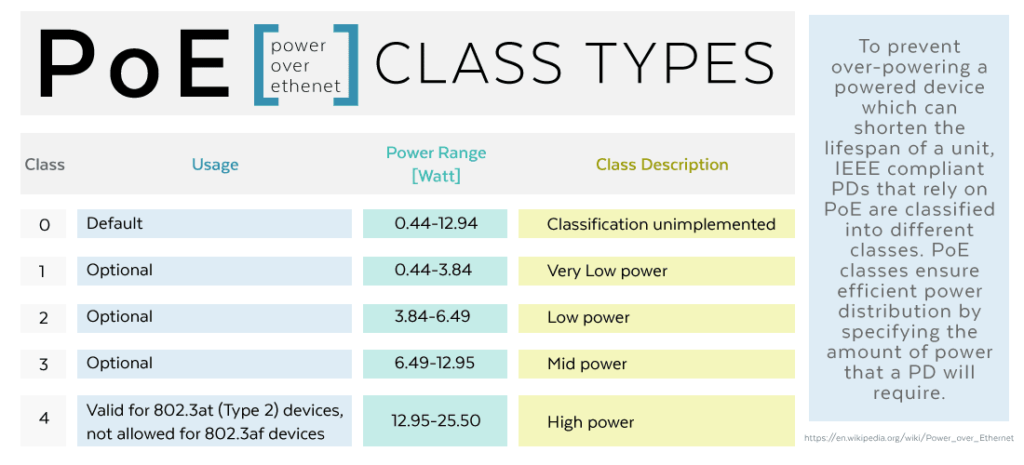 What are the advantages of PoE?
What are the advantages of PoE?
- Cost efficiency: PoE eliminates the cost of hiring professional electrical installers.
- Quick deployment: PoE simply requires plugging in networking cabling to the proper equipment to function correctly.
- Flexibility: Network administrators can deploy powered devices at nearly any location. Shielded cabling can be used for outdoor environments. Industrial-grade powered devices can be used for industrial environments.
- Safety: Because PoE utilizes a relatively low voltage, it presents low risks of electrical hazards.
- Reliability: PoE falls under IEEE’s strict 802.3 standard specifications.
- Scalability: PoE makes it simple to add new equipment to a network.
How does PoE reduce installation costs?
PoE installation costs are far less than installing traditional wiring, and the operating costs are far more efficient. One twisted-pair cable delivers both data and power to devices. Existing copper from legacy phone systems can also be repurposed. In addition, PoE injectors and splitters save money by allowing IT pros to combine legacy devices with newer, more efficient PoE networking components. They also enable organizations to add remote devices without having to install electrical infrastructure. Injectors and splitters are designed to provide power to and from non-PoE compliant equipment. These inexpensive units will add years to a legacy system and save thousands of dollars by bypassing the installation of electrical outlets in remote locations.
How are PoE deployments more responsive?
PoE devices adapt to changing environments. They can be easily moved and reconnected at the switch level and easily integrate into changing network configurations. PoE is plug-and-play. An entire network does not need to be brought down to add or subtract devices.
Why is PoE installation safer?
PoE Type 3 voltages are typically less than 60V, and Type 4 is less than 90V. Conduits and metal cladding are not required. Fewer steps and hazards and the straightforward use of one Ethernet cable remove the need for a licensed electrician.
What are PoE data-gathering capabilities?
PoE technology is perfect for data collection. For example, analytics software can help facilities groups to determine when an area is occupied and when LED lighting and HVAC components may be turned off. As a result, operational costs can be much lower based on actual usage.
How does PoE enhance productivity?
Because of two-way data capabilities, LED lighting systems can be programmed to follow the spectrum and frequencies found in nature. As a result, employees can enjoy greater health, alertness, creativity, collaborative opportunities, and a sense of well-being while on the job.
What are the limitations of PoE?
The limitations are few but should be taken into account when adopting for the first time:
- Simple PoE only transmits 100m.
- Non-compliant devices require additional equipment.
- Power budgets may only achieve levels available on legacy equipment.
Let’s look at these three limitations a bit more closely.
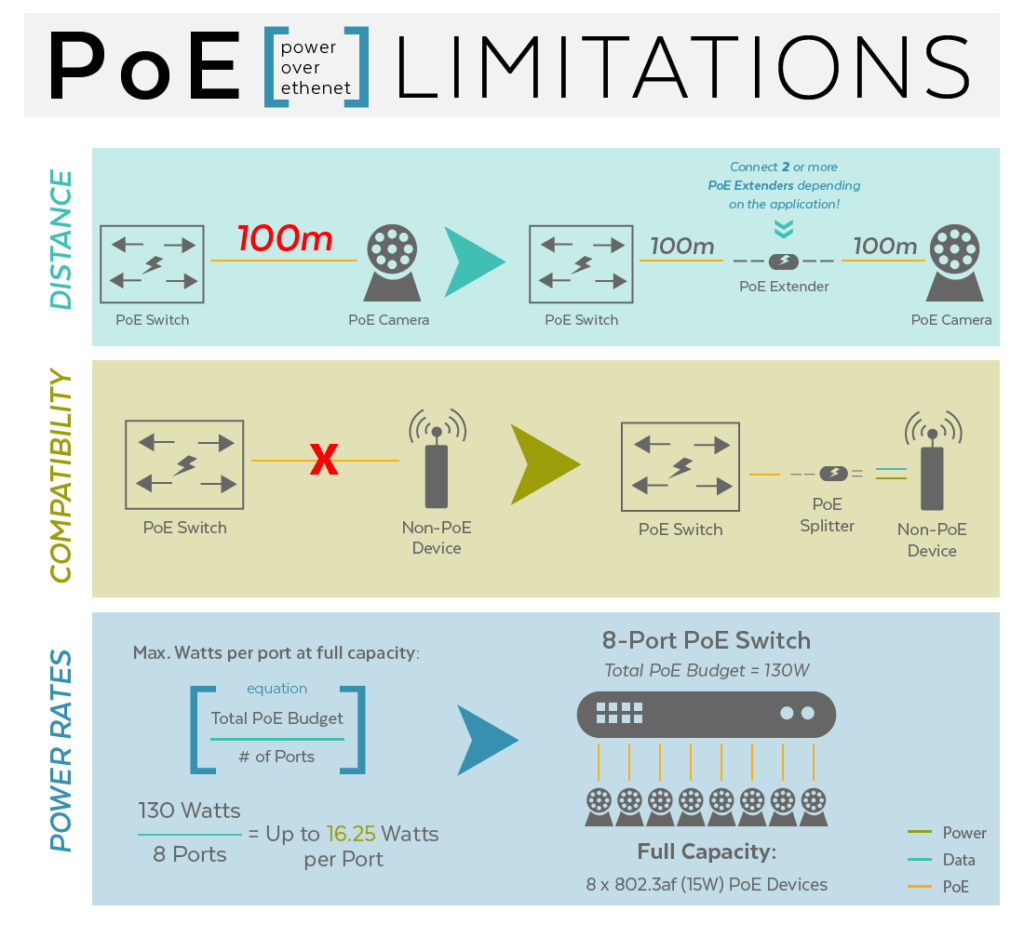 What is the maximum distance of PoE?
What is the maximum distance of PoE?
PoE can transmit 100 meters from the switch or hub to the Network interface controller (NIC), regardless of where the power is injected. The limitation is not the power; the Ethernet cabling standards limit the total length of cabling to 100m, the furthest distance a PoE switch can transmit simple data over Ethernet. A PoE Ethernet extender, however, can lengthen that span up to 4,000 feet. Extenders allow centralized control across a wide area for networks spanning enterprises, campuses, and large retail operations like shopping malls.
What does device compatibility refer to?
Legacy devices (those that are not PoE compliant) require either an injector or a splitter. PoE delivers power AND data over one cable and, therefore, one input. Legacy devices receive data and power separately.
Here’s how they work:
- PoE injector: Sends power to PoE equipment that receives data through an existing non-PoE switch
- PoE splitter: Also supplies power, but it does so by splitting the power from the data and feeding it to a separate input that a non-PoE compliant device can use
How much power can be delivered per port?
When purchasing, administrators want to be sure the maximum power budget of a switch is sufficient for the devices it supports. Identify the manufacturer’s power spec/budget per port to know if the end device will receive the necessary power through that switch.
What is a PoE power budget?
A power budget is the total amount of power a device can send through an Ethernet cable.
How much power can PoE devices supply?
PoE devices supply power according to the device IEEE 802.3 standard generation. The life-cycle generation is indicated by the extension: “af”, “at” (PoE+),or “bt” (PoE++ or UPoE). The following chart provides a side-by-side comparison of the maximum power each PoE Type delivers at the port level.
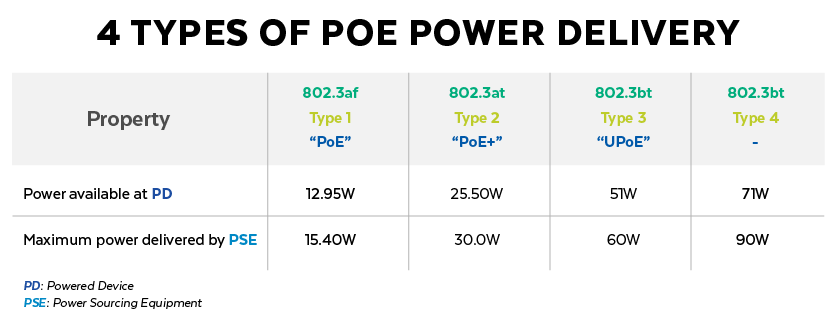
Allotting Sufficient PoE Power to Your Network
PSEs (such as switches and hubs) come with a predetermined Total PoE Budget. On the other hand, PDs (such as VoIP and IP cameras) come with various wattage demands, and the total must be less than the PSEs’ Total Point Budget.
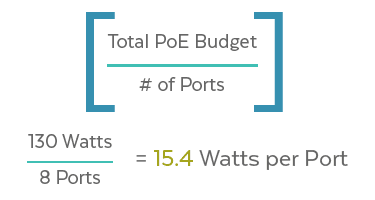
For example, an 8-Port PoE Desktop Gigabit switch has a Total PoE Power Budget of 130W and is 802.3af-compliant. Therefore, if used at total capacity, the maximum yield per port would be 130W divided by eight ports, which is 16.25W per port, rounded down to the nearest standard (in this case, the 802.3af standard). Because 802.3af PDs only draw 15.4W of power, the remaining power will stay unused, so the PDs are not overpowered. Even though the device has eight ports, network administrators must not make the mistake of assuming that the switch can be filled at a total capacity with 802.3at devices. To calculate how many 802.3at devices a unit supports, simply divide the Total PoE Budget by the Maximum PoE Output. With our example switch shown above, we divide 130W (Total POE Budget) by 30W (Maximum PoE Output) to get 4.33 (which we round down to 4). So, our example switch can service four 802.3at devices. Calculating the max amount of 802.af devices is just as simple: Divide Total PoE Budget by 15.4 watts.
What about PoE and cable configurations?
Each PD gains access to the network data through an Ethernet cable. Before PoE technology came on the scene, in addition to an Ethernet cable, each device also required a separate power cord. As the number of devices began adding up, managing all these cables was time-consuming and messy. The solution to cable mess came by combining data and power delivery over a single Cat5 Ethernet cable. Today, Ethernet cables are divided into Cat5 (nearly obsolete), Cat5e, Cat6, Cat6a, Cat7, and Cat8, each providing a higher noise and signal interference protection rate, respectively. The PSEs supporting these PDs have not changed, though. They are either PoE switches or PoE injectors. Knowing the best one for your implementation is the key to saving time and money. And, you will see that knowing which is not difficult once you understand the unique features of either.
What are the best devices for your PoE network?
There is a range of PoE equipment available for a variety of networking environments. Industrial PoE, for example, is made to withstand the extreme temperature demands characteristic of harsh industrial environments. Outdoor PoE gear often comes enclosed in a protective encasement to protect against the elements. Also, network installers need to ensure that their PSEs allot a sufficient PoE power budget to support the desired amount of PDs.
PoE Switches
A PoE switch is a network switch that can provide Power over Ethernet from each interface while still being able to forward frames. Both managed and unmanaged PoE switches are available. A PoE switch requires one Uplink to an existing network to further expand and increase ports.

What a PoE Switch Offers
An IT network switch is a multiport network hardware device that connects computers and smart devices and allows them to send and receive data. The PSE supports the transfer of data between MAC addresses over the data link layer. As the PoE switch (or injector, for that matter) connects to a device, it automatically determines whether that device is PoE compatible and whether it needs power. By making sure any new switches are PoE switches, you can ensure any PoE devices you need can easily connect to your network in the future. You are also ensuring that you can connect non-PoE devices, as they will support both without the risk of damage. An automatic step-down feature allows each device to detect a PD’s presence and determine whether it receives data or data and power. The IEEE PoE protocol also enables a PoE to switch (or injector) to detect the power level it needs to deliver. The delivery standard and amount of power each device needs is automated; however, you can determine the requirements by looking at the IEEE 802.3 extension. For example, a Type 1 device (IEEE 802.3af) can safely receive up to 15.4W of DC power. A Type device (IEEE 802.3at) accepts up to 30W.
Which Versa switches are PoE-capable?
The Versa switches that are PoE capable may be found on our PoE switch page. There are informational acronyms marked on the external chassis of each switch. Following are the acronyms and their meanings:
- DMS: device management systems
- UPOE: Ultra Power over Ethernet
- Gbe: Gigabit Ethernet
- PoE: Power over Ethernet
When it comes to maintaining a network, businesses need to assess their network demand to determine whether they need to choose between unmanaged PoE switches or managed PoE switches. Unmanaged PoE switches are relatively inexpensive, and their fixed configuration makes it easy to install the plug-and-play device. However, that is not to say that unmanaged PoE switches do not come with other hardware features. For example, unmanaged PoE switches can offer a redundant power input, extended operating temperatures, a nearly noise-free operation, among other hardware features. Many network administrators with heftier network demands opt for managed PoE switches. Many of these devices feature port-mirroring and, with the help of a protocol analyzer, can monitor the activity of incoming traffic, thus facilitating troubleshooting. Managed PoE switches also allow network administrators to monitor and prioritize traffic, set up VLANs, and program them through interfaces, such as Telnet, SNMP, or console. If you seek to update your network, visit our website for a more comprehensive collection of PoE switches, gigabit switches, managed Ethernet switches, and certified Industrial switches.
PoE Injectors
PoE injectors are midspan devices commonly deployed between a non-PoE-capable switch and a PoE-capable PD (such as an IP camera). PoE injectors add (or inject) power to a network cable to ensure that a connected PD can receive power and operate without a connected DC power supply. In short, a PoE injector makes a non-PoE PSE compatible with a PoE-capable PD. Thus, when spending the money for a switch is not practical, PoE injectors provide a versatile solution when fewer PoE ports are required.
Injectors allow administrators to populate and properly support LANs with both compliant and non-compliant devices.

The VX-Pi100 is an 802.3af-compatible PoE injector that can power connected devices like WAPs, VoIP phones, IP cameras, and HDMI extenders. Similarly, the VS-Pi1000GB-30 PoE injector provides the same function as the VX-Pi100 but can support gigabit speeds. For larger-scale deployments, multi-port PoE injector hubs (also known as PoE hubs) perform the function of multiple PoE injectors.
PoE Injector vs. PoE Switch
The IT network is the lifeblood of any business, and PoE technology saves companies a bundle while adding a single-cable solution for powering smart devices cross-platform. PoE adapts easily and scales to fit your implementation now while also adjusting to fit new configurations as your needs morph down the road. Deploying an additional IP phone, camera, or wireless access point does not have to break the bank. Depending on the power requirements of the PDs you are supporting, you may opt for a solution other than a new switch. That is because constructing or adding to an existing switch, even a loaded one, is more straightforward and less expensive than you might think. Getting the connectivity you need may be as simple as adding a PoE injector.
VX-GPU2626 PoE Switch
When needing many 90W ports, look for an ultra PoE 802.3bt-ready switch like the VX-GPU2626 L2s + 24-port managed GbE UPOE Switch (2200W) to support higher-powered PDs.
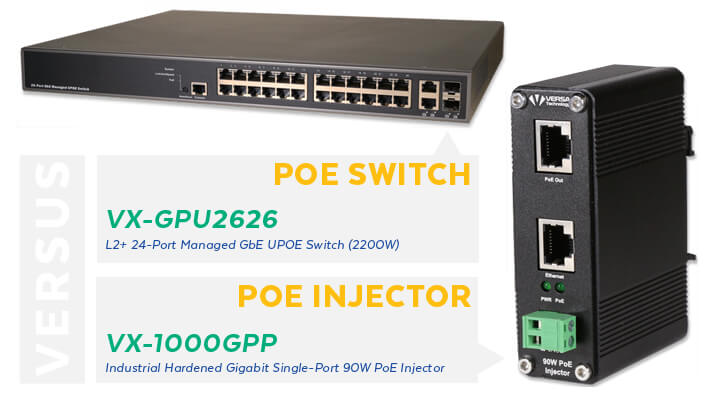
When you only need one port, look for the VX-1000GPP industrial hardened gigabit injector. It offers a power budget of up to 90W for a single port at a cost-effective price.
PoE Hub
A PoE hub can be viewed as a stack of PoE injectors. For example, a four-port PoE hub will have four data-in interfaces and four PoE interfaces. Each PoE interface requires a data connection with the corresponding data inside. A four-port PoE hub will require four data ports from the network switch. Data ports on the PoE hub will not forward frames within the hub. In other words, frames received on part one cannot be sent to parts two through four.
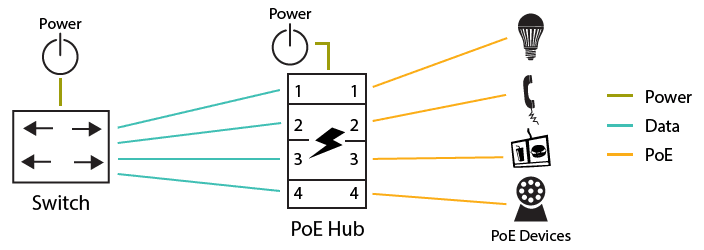 PoE Splitters
PoE Splitters
A PoE splitter supplies power to non-PoE-compatible devices by splitting power from data and feeding it to a separate input. Splitters are used on legacy and low-power devices like IP cameras to split PoE power from data signal and convert to lower-voltage requirements for the camera. In addition, a splitter allows a non-compliant device to upgrade to PoE.
 PoE Extenders
PoE Extenders
A PoE extender is used to lengthen a network beyond the basic 100-meter distance limit for a twisted-pair Ethernet cable. Extenders unite networks that span large distances in hotels, shopping malls, business and academic campuses, and sporting venues.
Industrial PoE Equipment
Industrial PoE equipment comes with stringent standards to ensure operation in extreme industrial conditions. PoE industrial equipment must have the capacity to protect against electrical decoupling, especially in electrically demanding environments, such as electrical substations. PoE industrial equipment, often described as “hardened,” supports extreme operating temperatures and additional optional protection measures, including dustproof and waterproof features.
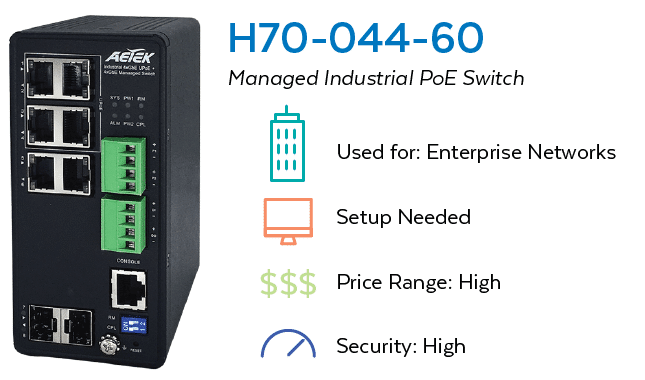 H70-044-60 Industrial PoE Switch
H70-044-60 Industrial PoE Switch
The H70-044-60 managed industrial PoE switch has two RJ 45 and two SFP interfaces, a power budget of 240W, and can be operated in temperatures between -40°C and 75°C.
What are the best applications for industrial PoE?
Industrial PoE applications help developers stay competitive. For example, sensors and IP cameras allow managers to observe manufacturing floors to monitor automated equipment and employee behaviors. This watchdog capability is essential to obtaining lean manufacturing development. PoE also facilitates large data transfer and power distribution to key areas. Following is a list of several Industrial PoE applications:
- Safety compliance can be better documented, therefore, helping to eliminate accidents in the work areas.
- Sensors help monitor accuracy along assembly lines and help to eliminate waste.
- Loading docks, inventory rooms, and other vital areas, even those without a local power source, can be tracked and improved using footage capturing employee transitions and downtimes.
- Sensors can track things that are not visible, such as temperature changes and protecting products at vulnerable stages of development.
What is PoE lighting?
One PoE application that is quickly gaining popularity is POE lighting. PoE lighting is a low-power, high-performance LED lighting network technology comprised of fixtures and sensors and is managed remotely using intelligent software. The control module communicates data signal and power over a twisted-pair cable. Network administrators use PoE to provide power to energy-efficient LED bulbs, using standard network cabling like Cat5e or Cat6 wiring. LED lights have an average lifespan of about 50,000 hours and use only six to eight watts of power per bulb. Therefore, with a PSE with a sufficient PoE budget, network administrators can deploy PoE lighting with a low amount of investment. In addition, standard networking cables are also a cost-effective alternative to the traditional electrical conduit used for wiring. PoE lighting gives users access to smart lighting using a simple internet connection. Furthermore, it provides users the ability to remotely control their lighting systems via a mobile client device or a web browser. LED light installations will not require a professional electrical installer. IT personnel are positioned as the new electricians of the future. PoE lighting allows office users to customize their work environments with flexible lighting endlessly.
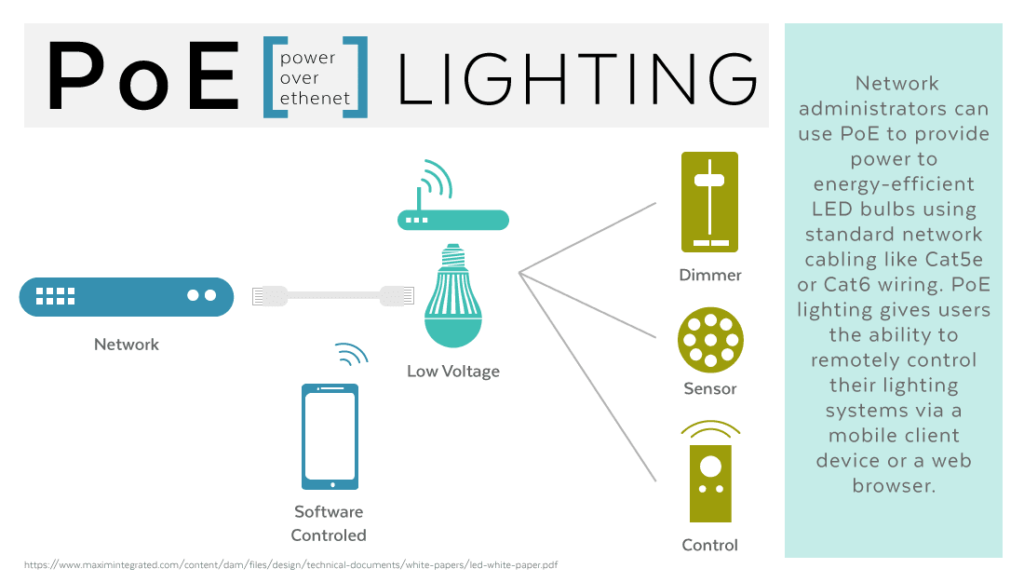 What are PoE lighting systems?
What are PoE lighting systems?
PoE lighting systems consist of PoE switches, lighting controls, sensors, and LEDs connected to LANs over twisted-pair cables. Lighting controls allow end-users to mirror the features of daylight to promote health, productivity, and collaboration using a broad spectrum of optical frequencies. With a PoE lighting system, data can be collected from motion sensors, allowing organizations to monitor better and control energy consumption. Individuals and organizations are leveraging these benefits in homes, work environments, academic settings, hospitality venues, and medical treatment facilities.
PoE in the Workplace
PoE is on its way to becoming THE source of electrical power in the workplace. PoE’s versatility is instrumental in co-working spaces that are commonly found in the startup sphere. These co-working spaces are often occupied by freelancers and independent contractors where office arrangements are never permanent. As PoE adopts more applications beyond computer networking, it can potentially act as a shifting power source that new users can easily modify without the help of professional installers.
The Future of PoE and IoT
PoE allows for flexible network designs that are simple to deploy. In addition, the practicality of PoE wiring leaves future application possibilities for PoE open for exploration. In the wake of the Internet of Things (IoT) revolution, PoE is positioned to gain traction. As an increasing amount of objects and sensors connect to the internet, PoE has the potential of becoming as integral to infrastructure as electrical circuitry. This prospect seems more viable, especially with ratifying the 802.3bt standard that has given us high-power PoE.
Frequently Asked Questions About PoE
1. When should you use PoE?
PoE allows you to add a device in awkward or remote locations. It is excellent for WAPs, CCTV camera placements, and digital signage on the tops or sides of skyscrapers. It is suitable for IT network installations as well. Cables for IP devices and small, out-of-the-way networks can be boosted for distances beyond 100m for a single device through the use of PoE injectors. PoE can be used over existing copper telecom infrastructure.
2. When should you not use PoE?
PoE is not recommended to send network data over long distances or extreme temperatures unless an industrial designation is present.
3. What type of data speeds does PoE offer?
PoE costs less than fiber and is delivering higher and higher data speeds. Thanks to the widespread adoption of IEEE 802.3bz technology, manufacturers are spending more on product development. Data delivery rates are now at 1 Gbps (10/100/1000 Mbps) over Cat5e and Cat6. The new IEEE 802.bz standard can deliver speeds of 2.5 to 5 Gbps over 100m leverage with an immediate view toward 10 Gbps. High-definition streaming only requires 400 Mbps. A network could easily stream a training video while others work and check email. PoE has more than enough data speed to support devices in a small LAN.
4. What levels of power can PoE deliver?
PoE does not require an additional power supply. The previously developed standard—IEEE 802.3at—provides 30W of power. The most recently developed standard—IEEE 802.3bt—provide 60W (Type 3) and 100W (Type 4)
5. What type of devices does PoE support?
PoE can support a huge range of devices, and that list is expanding. In fact, manufacturers are developing network devices with the convenience of PoE in mind. PoE technology works indoors and outdoors. In places where there are extreme temperatures, installers keep cables and devices in protected areas like under the eaves or in the shade. Even the latest standard, IEEE 802.3bt supports legacy devices. These are devices not manufactured to PoE standards. These devices may be added to a PoE network inexpensively through the use of a PoE splitter. Poe 802.3at devices include things like video phones, speed dome cameras, and WiMax wireless access points. PoE 802.3bt devices include things like thin clients, point-of-sale systems, laptops, and digital signage.
6. What types of costs should I expect with a PoE installation?
PoE costs less to install than fiber cabling. Cat5e/Cat6 Ethernet cable, which appears in many existing infrastructures, as well as, the more recent Cat6a cable are considerably less expensive than fiber over the scope of an installation. Since both the PoE networking equipment and compatible devices are also becoming plug-and-play, PoE is making network upgrades feasible from both a budgetary and IT resource perspective. And because power delivery is through the cable, there is no need to hire a contractor to install an electrical outlet for a remote device. And finally, from a technological standpoint, PoE is as “green” as you get.

